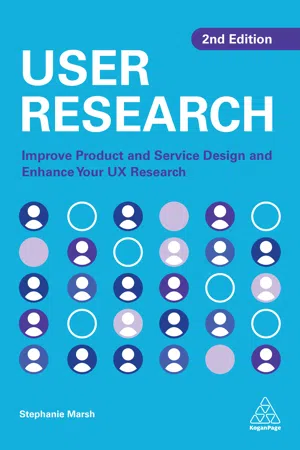
User Research
Improve Product and Service Design and Enhance Your UX Research
- English
- ePUB (mobile friendly)
- Available on iOS & Android
About this book
Despite businesses often being based on creating desirable experiences, products and services for consumers, many fail to consider the end user in their planning and development processes. This book is here to change that.
User experience research, also known as UX research, focuses on understanding user behaviours, needs and motivations through a range of observational techniques, task analysis and other methodologies. User Research is a practical guide that shows readers how to use the vast array of user research methods available. Written by one of the UK's leading UX research professionals, readers can benefit from in-depth knowledge that explores the fundamentals of user research.Covering all the key research methods including face-to-face user testing, card sorting, surveys, A/B testing and many more, the book gives expert insight into the nuances, advantages and disadvantages of each, while also providing guidance on how to interpret, analyze and share the data once it has been obtained. Now in its second edition, User Research provides a new chapter on research operations and infrastructure as well as new material on combining user research methodologies.
Frequently asked questions
- Essential is ideal for learners and professionals who enjoy exploring a wide range of subjects. Access the Essential Library with 800,000+ trusted titles and best-sellers across business, personal growth, and the humanities. Includes unlimited reading time and Standard Read Aloud voice.
- Complete: Perfect for advanced learners and researchers needing full, unrestricted access. Unlock 1.4M+ books across hundreds of subjects, including academic and specialized titles. The Complete Plan also includes advanced features like Premium Read Aloud and Research Assistant.
Please note we cannot support devices running on iOS 13 and Android 7 or earlier. Learn more about using the app.
Information
The fundamentals What good research looks like
Planning your user research
When is the right time to do user research?
Be clear what your research is about
What’s your problem?
Planning your user research
Table of contents
- Preface and acknowledgements
- 01 Introduction: why is user research so important?
- PART ONE The fundamentals: what good research looks like
- 02 Planning your user research
- 03 Best practice in user research: who, what, why and how
- 04 Getting the legal and ethical stuff right
- 05 Setting up for success
- 06 Managing user research logistics: agencies, facilities and contracts
- PART TWO Selecting and using user research methods
- 07 Usability testing: observing people doing things
- 08 Content testing: what do people think your content means?
- 09 Card sorting: understanding how people group and relate things
- 10 Surveys: how to gauge a widespread user response
- 11 User interviews: understanding people’s experience through talking to them
- 12 Diary studies: how to capture user research data over time
- 13 Information architecture validation through tree testing: does the structure of your information work for your users?
- 14 Ethnography: observing how people behave in the real world
- 15 Contextual inquiry: interviewing people in their own environment
- 16 A/B testing: a technique to compare options
- 17 Getting the best out of stakeholder workshops
- 18 Guerrilla research: running fast-paced research in the real world
- 19 How to combine user research methodologies
- PART THREE Analysing user research data
- 20 Content analysis: understanding your qualitative data
- 21 Identifying themes through affinity diagramming
- 22 Thematic analysis: going beyond initial analysis
- 23 Agile analysis
- 24 Analysing usability data and cataloguing issues and needs
- 25 Analysing data to create personas to communicate user characteristics and behaviour
- 26 Analysing data to create mental models: visualizing how user think and identify opportunities
- 27 Turning findings into insights
- PART FOUR UX storytelling: communicating your findings
- 28 Making recommendations: how to make your research findings actionable
- 29 Creating executive summaries and detailed reports to present results
- 30 Using video playback to present your research results
- 31 Using journey and experience maps to visualize user research data
- 32 Using scenarios and storyboards to represent the user journey
- 33 Using infographics to translate numerical and statistical data
- 34 How to recommend changes to visual, interaction and information design
- Conclusion
- Index